By: Amy Yu
JINKA, ETHIOPIA
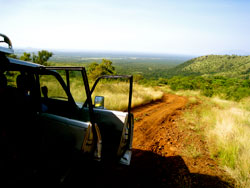
(click to enlarge)
|
I'm down here in the Lower Omo Valley of the Southern Nations Region of Ethiopia visiting the Mursi tribe, staying in Jinka, a small village that serves as a natural gateway to the many colorful tribes in the western area of the Omo, which is a couple hours drive from the Ethiopian capital of Addis Ababa. The drive south to Jinka from Addis took two days of extremely rough driving. There is no accessible public transportation around the Omo Valley connecting the areas in which these amazing tribes live. And calling it "rough driving" would be generous, as "off-roading" was really more what we were doing in some areas. Originally, we were planning to hitch our way around the villages and tribes for a week, but after some further research in Addis realized it is really not possible. There are no lorries or delivery trucks coming to these tribes, and these tribes aren't living in accessible villages off the main road. Our only option was then to hire a private jeep with a local driver to take us around for a week.
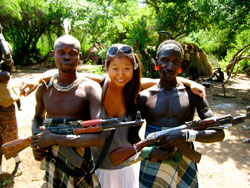
(click to enlarge)
|
Jinka itself is a rather quiet village. Internet connection is a joke and there aren't many options for food (spaghetti twice a day), but there is a large field that was once used as a small airstrip. Local guys gather here every day around 5pm for a few games of football (alongside grazing cows), and this is how we spend our time in our evenings back in Jinka.
Upon entering the Mursi's land, we are stopped by a group of scouts and encouraged by our driver to take one with us. We didn't really feel it was necessary to take an AK-toting scout as we didn't feel we needed protection from anything, but in the end we were forced to take a scout anyway. So by "encouraged" they actually mean "mandatory." In addition, when visiting the Mursi you are also “encouraged” to do so in the morning before they get drunk and "volatile" in the afternoon. I find this hilarious. So these tribes are not accessible by public transportation, have no real roads leading to their huts, and don't have stores around to buy things. Yet somehow, they have plenty of nice guns and foreign liquor.
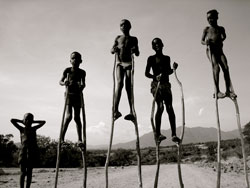
(click to enlarge)
|
The Mursi tribe, about 6,500 people inhabiting this area of the Mago National Park, speaks not Amharic (they can't communicate with our driver), but another of the 90 tribal languages spoken in Ethiopia. Only 15% of them are Christian, the rest being Animists, and are mostly pastoralists that practice flood retreat cultivation living in simple huts made of what looks like just hay or straw. Their men participate in fierce stick-fighting, a strong Mursi tradition, while both sexes engage in scarification, a process by which they cut their flesh and rub gunpowder into the wound, engaging infection to yield raised scars. These raised scars are supposed to make you "desirable." Mainly though, their biggest claim to fame is the wearing of the clay lip plates by some of their women. As these discs cause quite a bit of discomfort, the women only wear them for part of their time. The females receive their first incision in their lips in their early teens and from there gradually stretch the wounds further and further. There have been lip plates 25cm wide reported, but most that I see seem to max out at 15-20cm.
Wrinkled in its limp, unstretched form, the slice of lip separated from the rest of her face sways around loosely as Mursi woman shakes her head at me. The crescent-shaped hole under her jaw gapes with its big, empty space. I want to punch my fist through to see if it will fit, but the look in her eyes doesn't seem so welcoming. With that, she takes her left hand to her mouth and stretches the bottom lip outwards and down. Her right hand places a 20cm diameter clay disc on the edge of her lower lip, carefully laying the flesh down in the groove running the exposed circumference of the plate, snapping the top of the disc in place right under her lower set of teeth. Quite impressive. The Mursi tribeswoman shakes her head again, the disc bounces back and forth now firmly in place. That thing is about the size of my face, but probably bigger. Fascinating, mind-blowing, and awe-inspiring. This is the kind of stuff only National Geographic photographers get to see.
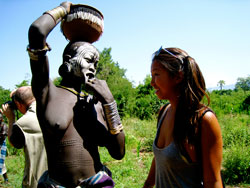
(click to enlarge) |

(click to enlarge) |
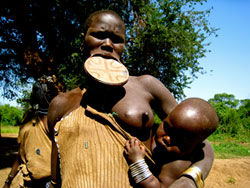
(click to enlarge) |
We’ve all heard the stories of primitive people who believe that camera flashes steal their soul. Well, they really exist. And I’m meeting them face-to-face. Lucky for me, and all those National Geographic photographers, these primitive people seem to not value their souls all too highly. Conveniently enough, these tribes people are willing to “sell their souls” and weather the flash for the small price of twenty Ethiopian birr, equivalent to about twenty US cents.
Aside from these tribes here in Ethiopia, wooden lip-plates are also worn by tribes in Brazil. To be honest, I can't seem to pin down the explanation for these lip-plates. One person told me it was a symbol of wealth for the family. Another told me it was meant as protection against slavers and evil spirits entering their bodies by way of the mouth cavity. I'm not sure what to believe, but now as I try to imagine us ripping 25cm wide holes in our mouth to prevent against being snatched into slavery, modern-day braces to keep our teeth shiny and straight don't seem as big of a burden.
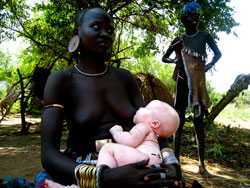
(click to enlarge)
|
As we were leaving, we walked past a blindingly white baby wrapped in the arms of a very black-skinned Mursi woman. It was a very strange spectacle and as I sat there staring, my driver told me that it was rumored to be a mixed baby of the Mursi woman and a white researcher who lived in the area for a while. It was obvious to me that it was definitely not a black/white mixed baby, but an albino one. (Interesting fact: in much of East Africa, albino humans are actually hunted and their body parts sold as "luck charms" for businesses, etc.) I tried explaining to our driver and our scout (who I'm pretty sure would have proved to be absolutely useless had the entire male population of the tribe become enraged in drunkenness and decided to gun us down with their superior firearms) that this was not the baby of a white man, but was a baby with a medical condition that produces humans with little to no pigmentation. I'm not sure he believed me.
Later that night back in Jinka, we get a knock on the door. It is our driver and a white guy, who I later learn is the researcher the Mursi knew. He has been on vacation back in London for the past couple months and only knew the woman when she was pregnant. This guy is in an exceptionally apprehensive state and wants to see my photograph of the baby. Upon viewing it, he is extremely glad that he heard about our excursion because now he knew he couldn't return to the tribe. Apparently they would kill him if they thought he fathered a Mursi baby. Yikes.
All photographs are the property of Amy Yu. |